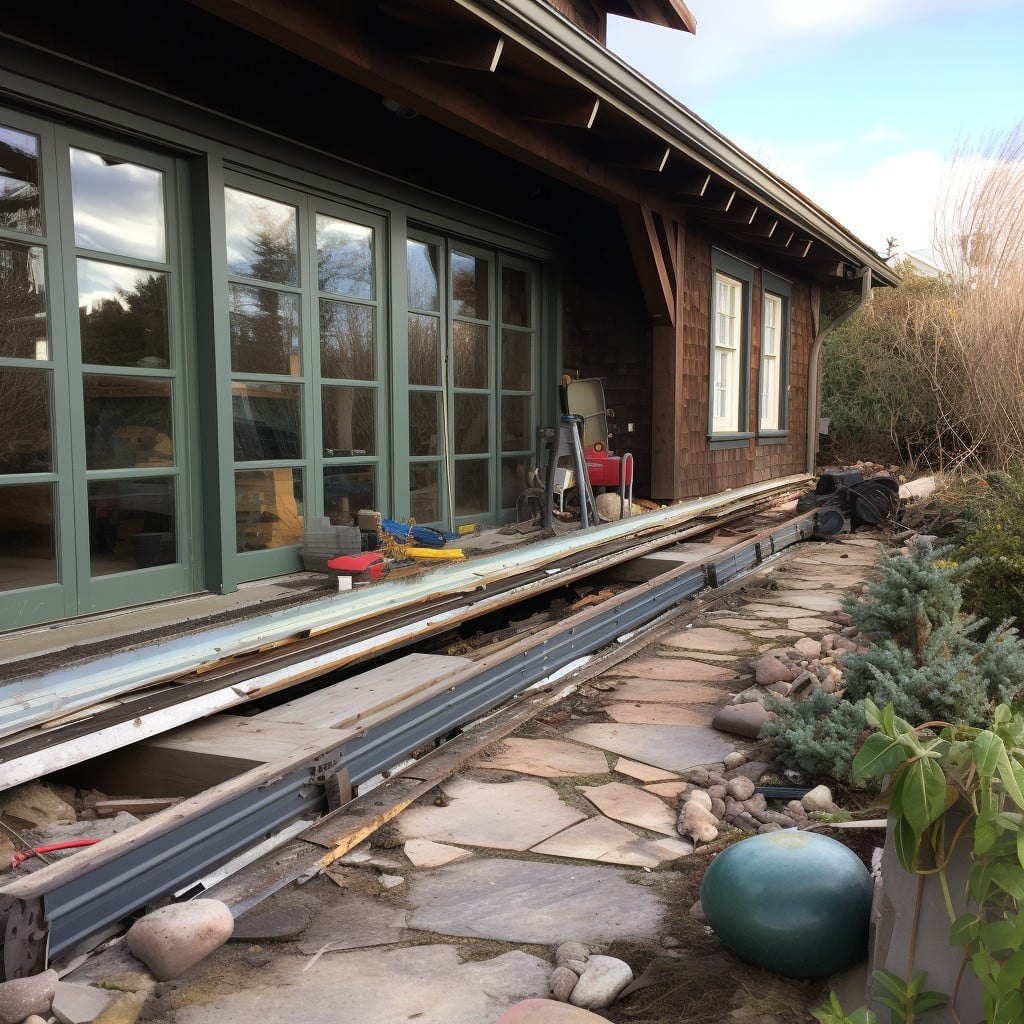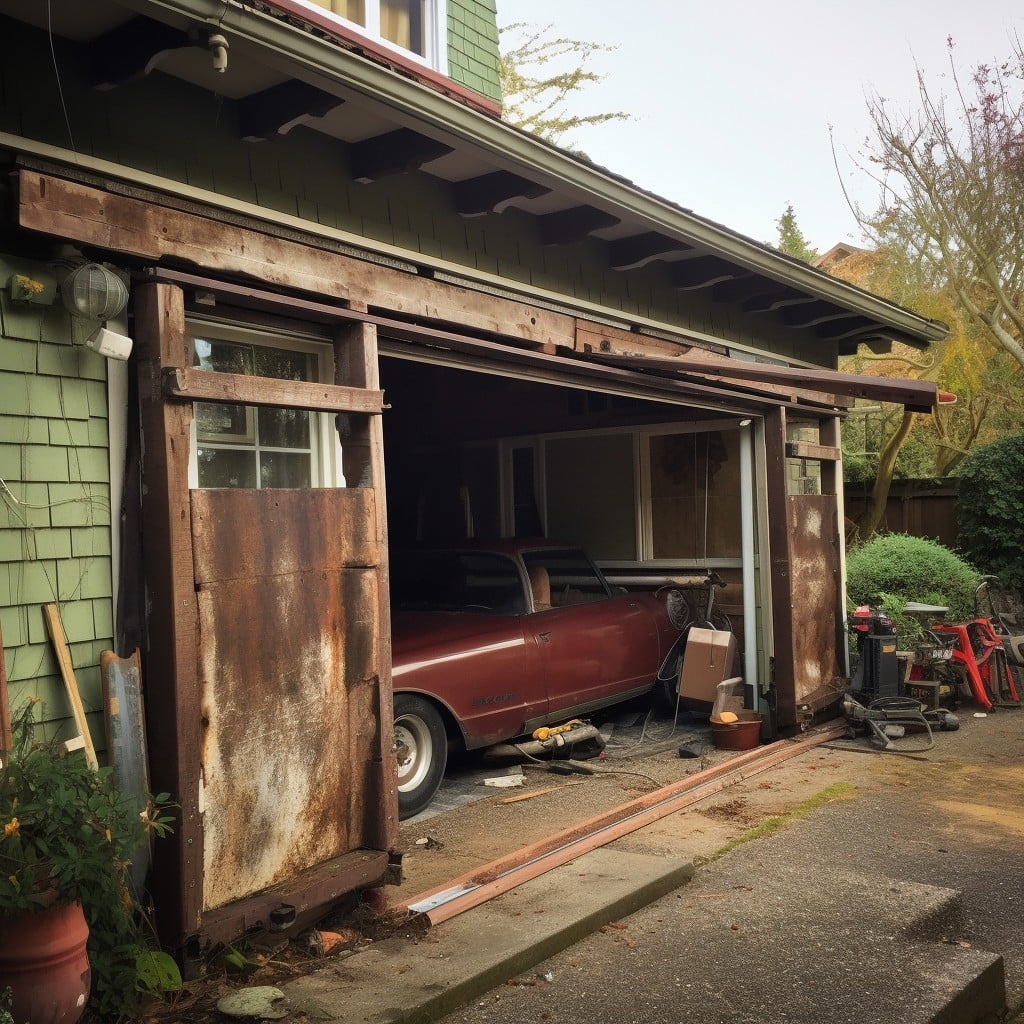Explore the step-by-step process to efficiently install a new garage door on old tracks, ensuring safety and functionality throughout.
Installing a new garage door on old tracks can be a cost-effective way to refresh your garage’s look and functionality. This process involves careful measurements, the right tools, and a keen understanding of the garage door mechanism.
This article will guide you through the necessary steps, ensuring you have all the details to carry out the task with precision and safety. Whether you’re a seasoned DIY enthusiast or a novice, this guide will make the process straightforward and manageable.
So, let’s dive into the world of garage door installation and learn how to fit a new door onto old tracks with ease and confidence.
Key takeaways:
- Asses the condition of the old track
- Understand door and track compatibility
- Check the safety of old garage door parts
- Potential for property damage due to deteriorating tracks
- Comparing old tracks and modern tracks
Assessing the Condition of the Old Track

Conducting an inspection of your current setup is a vital first step. Check for signs of wear and tear that indicates potential weakness in the system. Look for loose screws, tarnished rails, and blemishes on the steel, as these could adversely affect the operation of the garage door.
An alignment verification is another part of this condition assessment. Tracks that are misaligned will hinder the smooth operation of the door and could even cause it to derail. One simple way to check this is to observe the path of the roller through the track; if there are spots where the roller either binds or moves away from the rail, these signify alignment issues.
Remember that rust is more than just an unsightly blemish. Excessive rust can weaken the structural integrity of the tracks and shorten their lifespan. You should assess whether the rust is surface-level or has penetrated deep into the material. Severe rusting necessitates an immediate track replacement.
Finally, listen to the sounds your existing garage door makes during operation. Unusual or excessively loud noises are often a red flag indicating potential faults in the tracks. Delaying addressing these issues could lead to more significant problems down the line.
Understanding Door and Track Compatibility

Different garage door models have unique track configurations. Compatibility isn’t always guaranteed, even among doors of the same size. For example, brands may use various track diameters, so a new door fitting perfectly into an old track is not a given.
Track profiles further add to complexity. While most are standard vertical lift, others might be high-lift or full vertical lift. Installing a door designed for the former onto tracks meant for the latter can hinder the mechanism’s smooth operation.
Ensure that you measure your old track and cross-reference these measurements with the specifications of your new garage door. Take into account track curvature – a misfit here can lead to unsafe operation, unnecessary wear, or even damage to the door.
Lastly, whether your old track is a two-inch or three-inch track could impact compatibility. While many residential garage doors use the two-inch track, some larger doors or industrial-use doors require a three-inch track. Ensuring a match between the old track and the new door is paramount.
Checking the Safety of Old Garage Door Parts

When inspecting your existing track set-up, safety should be at the forefront of your considerations. Watch for signs of wear and tear like rust, dents, or misshaping. These can indicate potential weak points in the structure that could cause a malfunction.
Examine all brackets, bolts, and screws for similar signs of damage or fatigue. A loose bracket or worn screw could result in the door coming off its track, a risk you don’t want to take.
Additionally, make sure any spring system linked to the tracks is still in good working order. Overstressed or overstretched springs can lead to serious injury if the door is in operation.
Remember, while checking parts for safety, you’re not just evaluating their current condition, but also projecting their fitness for continued future use. The goal is to ensure an accident-free, smooth-operating garage door for as long as possible.
Potential for Property Damage Due to Deteriorating Tracks

Continued use of old, deteriorating tracks can lead to several potential property damages. Firstly, an unstable track could give way under the weight of the door, causing it to collapse. This could inflict serious damage not only on your garage but also on anything that could be underneath it at the moment.
Secondly, worn-out tracks often prevent the door from closing completely. This gap can expose your garage to weather elements, leading to damages such as rusting tools or warped woodwork. Additionally, it compromises your home security and might lead to burglary or other unwanted intrusions.
Lastly, the grinding of a door against a faulty track can lead to rapid wear and tear of both components. Contrary to usual wear over time, this could result in premature replacement of both items, leading to unexpected expenses.
To mitigate these risks, it’s essential to regularly inspect your tracks for any signs of deterioration. Keeping a close eye on the smooth functioning of your door could save you from larger issues in the future.
Comparing Old Tracks and Modern Tracks
Old tracks were often made from heavy-duty steel, engineered to last for extensive periods. Although durable, they can become misaligned over time, leading to operational problems. On the other hand, modern tracks are usually made lighter to reduce overall door weight, while the manufacturing quality has been significantly improved for longevity and performance.
Having built-in advancements, contemporary tracks typically hold up better against rust, aiding in smoother door movement. Additional protective coatings can also prevent any potential damage caused by harsh climatic conditions.
Notably, newer tracks are designed specifically to accommodate modern safety features – a significant upgrade not available with older configurations. For example, they can attach to safety sensors or accommodate advanced pulley systems, lowering the risk of accidental injury or property damage.
In terms of installation, modern tracks are often easier to install due to the user-friendly nature of their design. They provide convenience by being pre-drilled for hardware and detailed with laser-edged instructions right on them.
Stay aware though, that the differences between old tracks and newer models are not just visible in the material or construction, but also when it comes to compatibility with various garage door types. Not all tracks are suitable for every door, and the consistency between door-type and track-type ensures smooth operation and longevity of the setup.
Exploring the Disadvantages of Not Replacing Tracks
Utilizing old tracks for a new garage door can pose several drawbacks. Firstly, the issue of compatibility arises. Even if your new door matches the exact size of the old one, it may not align properly with the existing track alignment due to variances in shape, weight, or balance points.
Secondly, the age and wear on your old tracks can lead to operational problems. Over time, tracks can warp or get bent, causing the door to open and close unevenly, leading to potential damage to your new door.
Lastly, the safety of your garage space can be compromised with dated tracks. The newer doors come with more advanced safety features that cannot be supported by older tracks.
Ultimately, being cautious about reusing old tracks can save you from unnecessary hassles and additional costs in the long run.
Recognizing the Advantages of Replacing Tracks
When it comes to total door performance and longevity, use of new tracks proves crucial. Just like a new garage door, fresh tracks are precisely fabricated and calibrated for smooth operation.
Choosing to update tracks can extend the lifespan of your door. They are designed to accommodate the weight and size of your new door, reducing strain on the system, decreasing the chances of breakdowns, and minimizing the need for future repairs.
Investing in new tracks also boosts safety. Updated track models feature improved designs that integrate better with modern safety mechanisms. And remember, every component of a garage door operates interdependently; a weak track system can undermine the overall function and safety.
Moreover, replacing tracks can enhance your garage’s aesthetic appeal. New tracks, free from rust and wear, compliment your new garage door, offering a complete, polished appearance.
Finally, new tracks typically come with a manufacturer’s warranty, offering peace of mind and cover against unexpected problems. Do consider this option; the initial cost may be higher, but the array of benefits and potential savings in the long run make it a worthy investment.
FAQ
Can I replace garage door without replacing track?
Yes, it is possible to replace a garage door without replacing the track, but it's recommended to replace both to ensure the best fit and prevent future problems.
Can you use existing rails for new garage door opener?
Yes, while physically possible, it is strongly advised to replace all components, including existing rails, when installing a new garage door opener for optimal performance and safety.
Can you reuse garage door rails?
Yes, you can reuse garage door rails, but it's not recommended due to the precision fit and wear concerns, which would compromise the overall functionality and safety of the garage door.
Can I use the same track for a new garage door opener?
No, you cannot use the same track for a new garage door opener; every time you replace an opener, all parts, especially the rails, need to be replaced and the entire system rebuilt to suit the new opener for proper functioning.
Is it feasible to adjust my old garage door tracks for a new door?
While feasible, adjusting old garage door tracks for a new door is not recommended as inconsistencies in alignment can cause unnecessary stress and premature wear on the new door.
What factors should be considered when deciding to reuse old garage door tracks?
When deciding to reuse old garage door tracks, consider factors such as their condition, compatibility with the new door, safety standards, and the cost and time-saving benefits.
Does the material of the new garage door affect the usability of the old tracks?
Yes, the material of the new garage door can affect the usability of the old tracks as heavier doors may require stronger, more robust tracks.